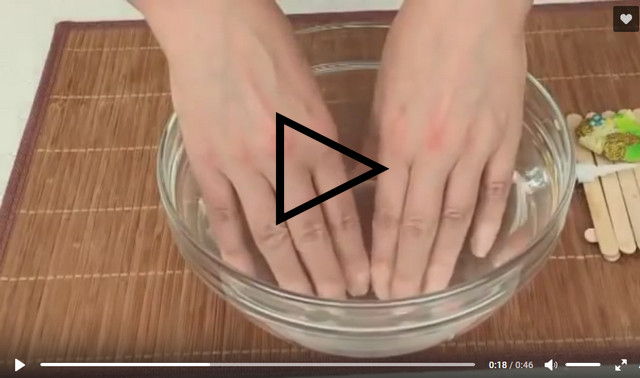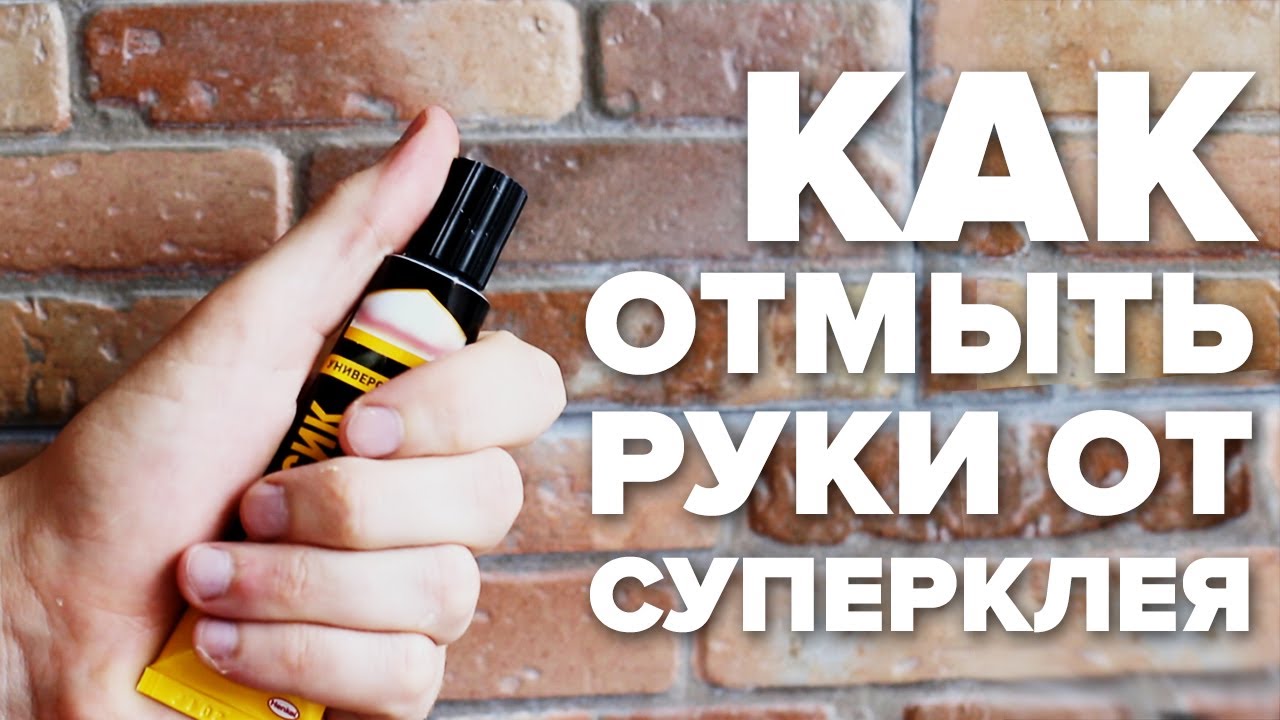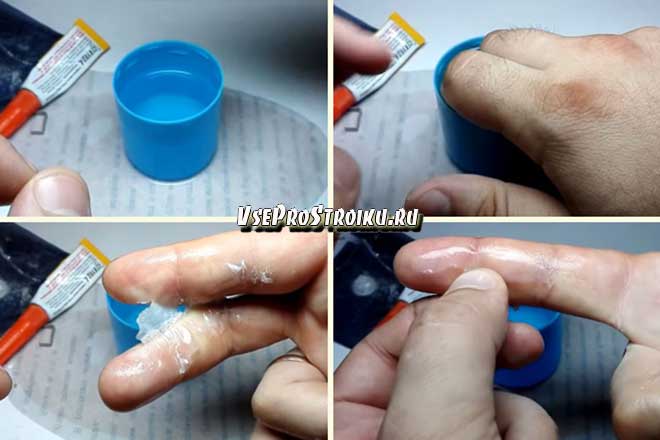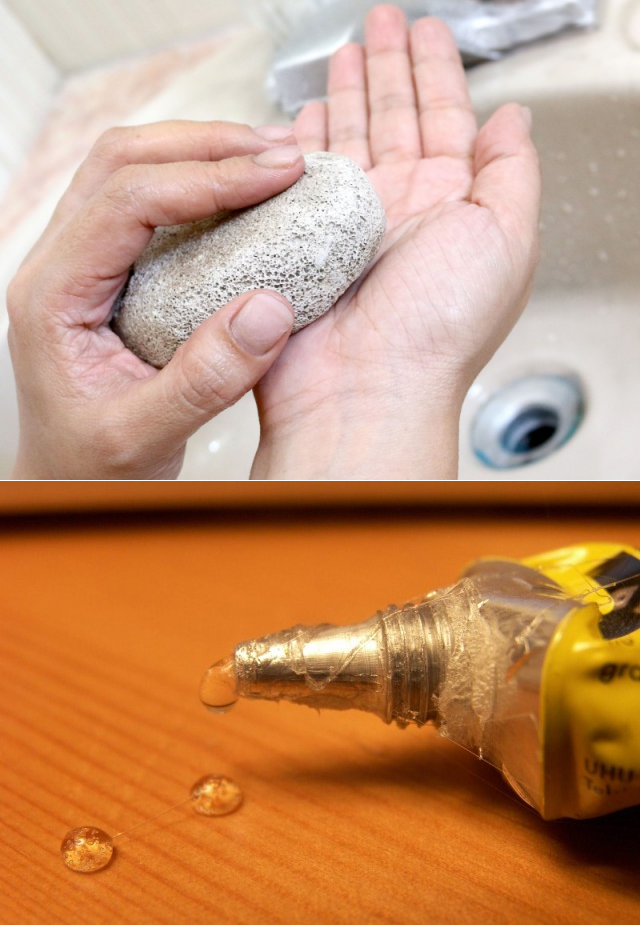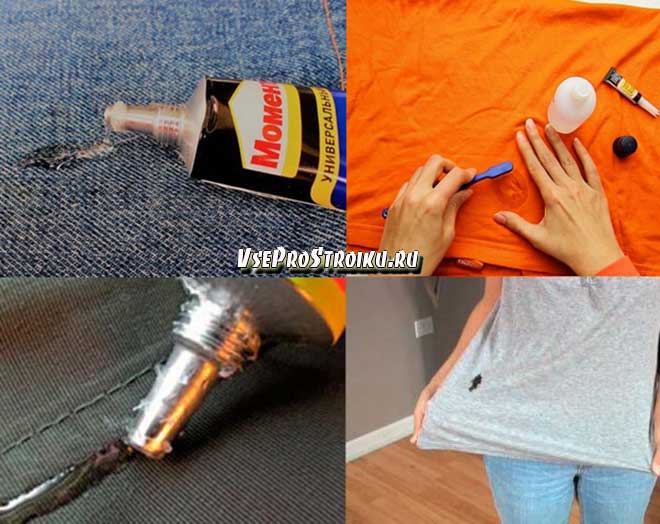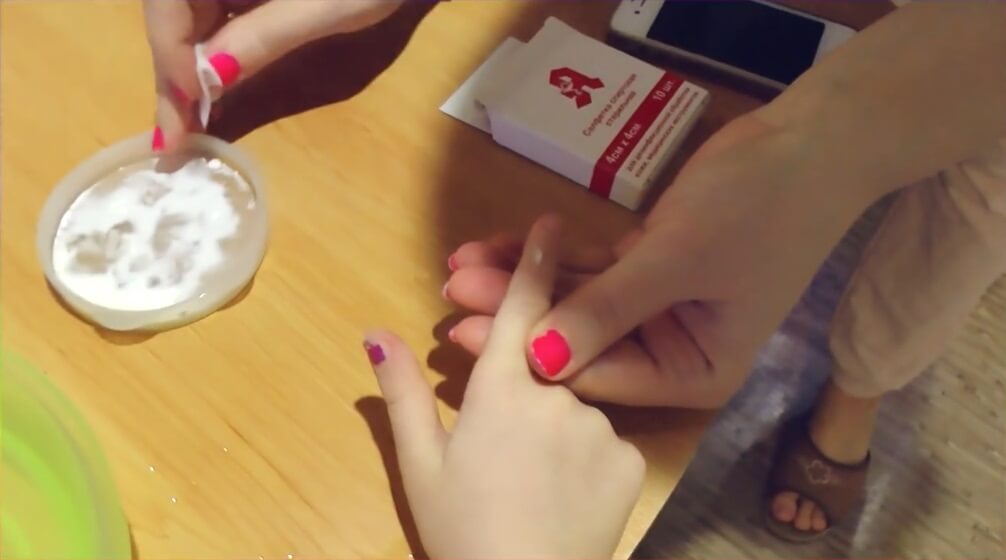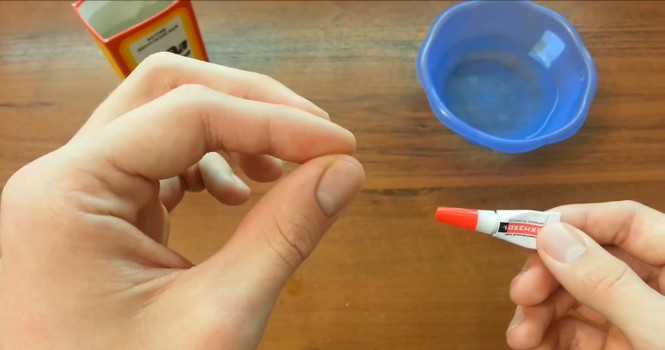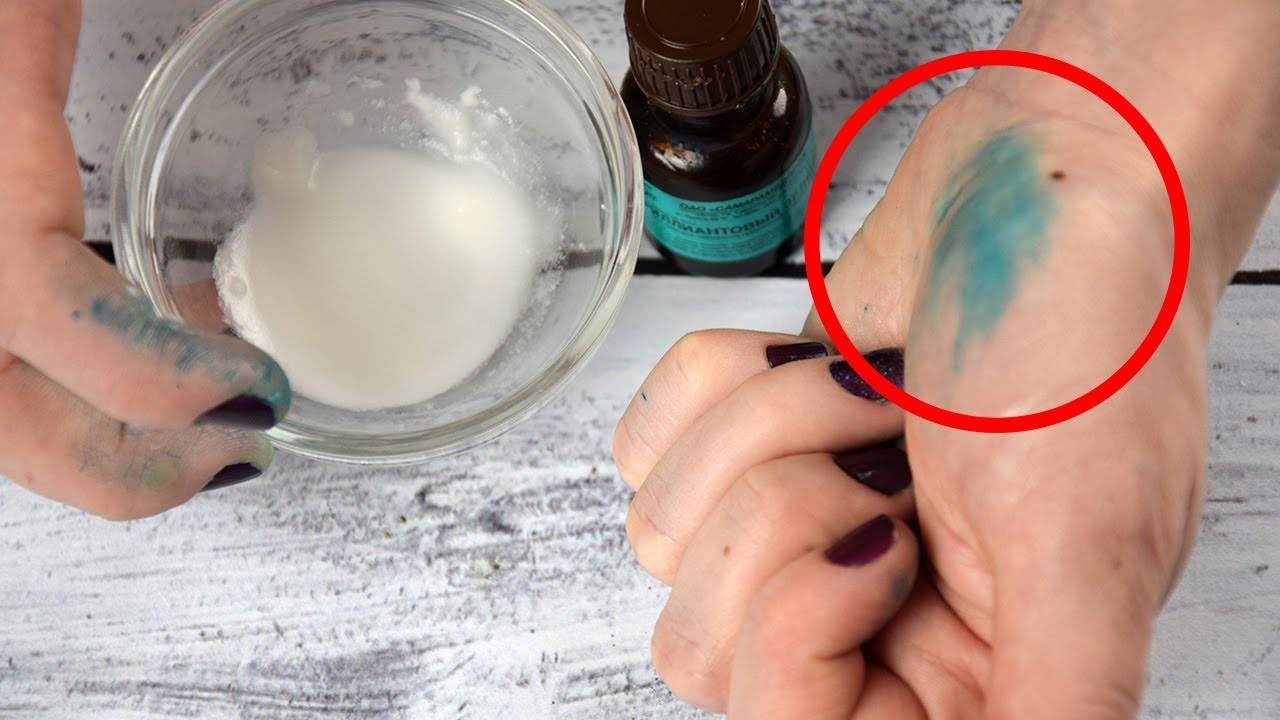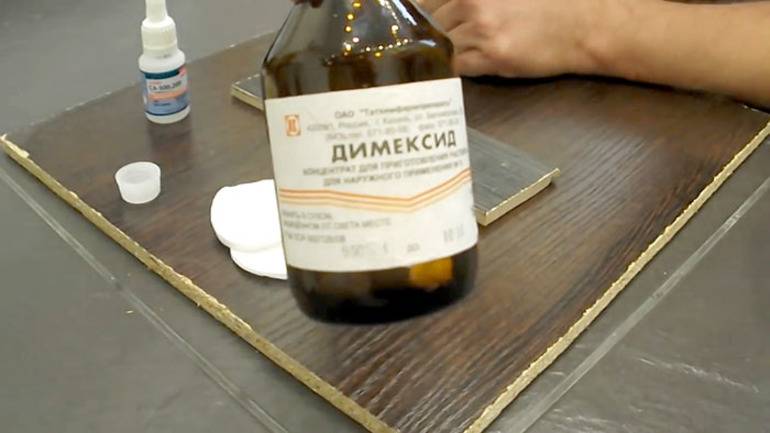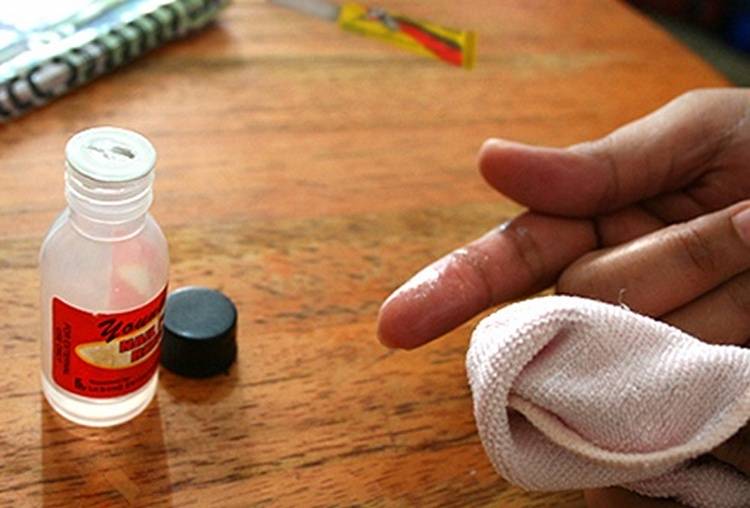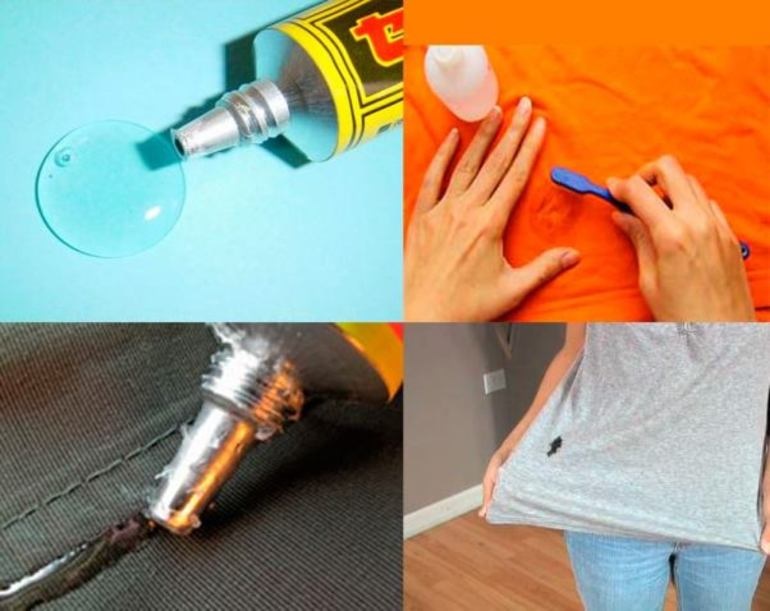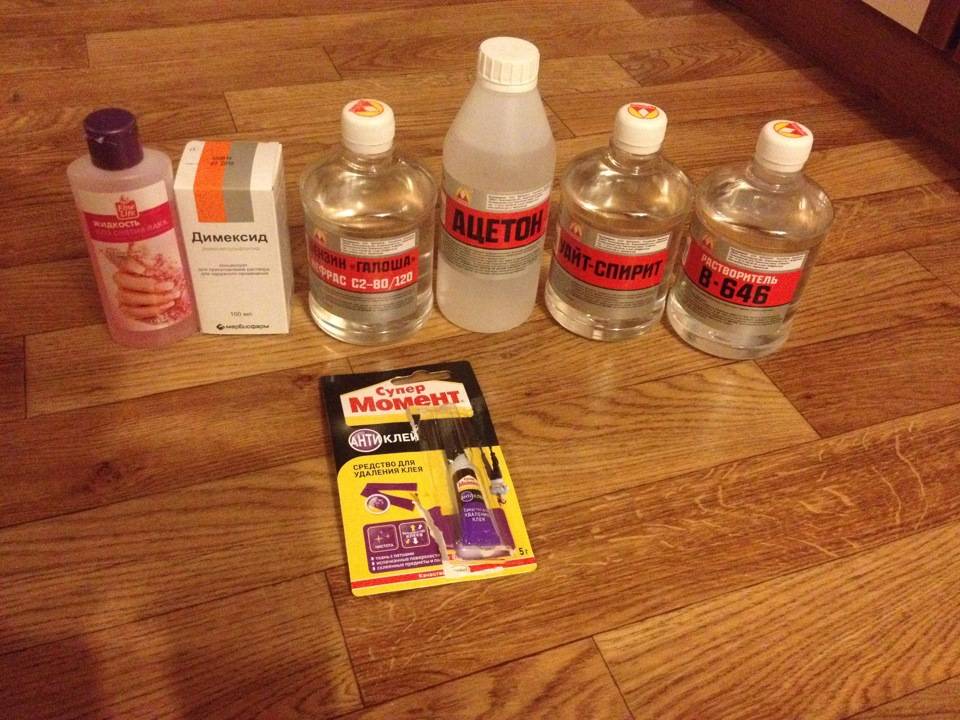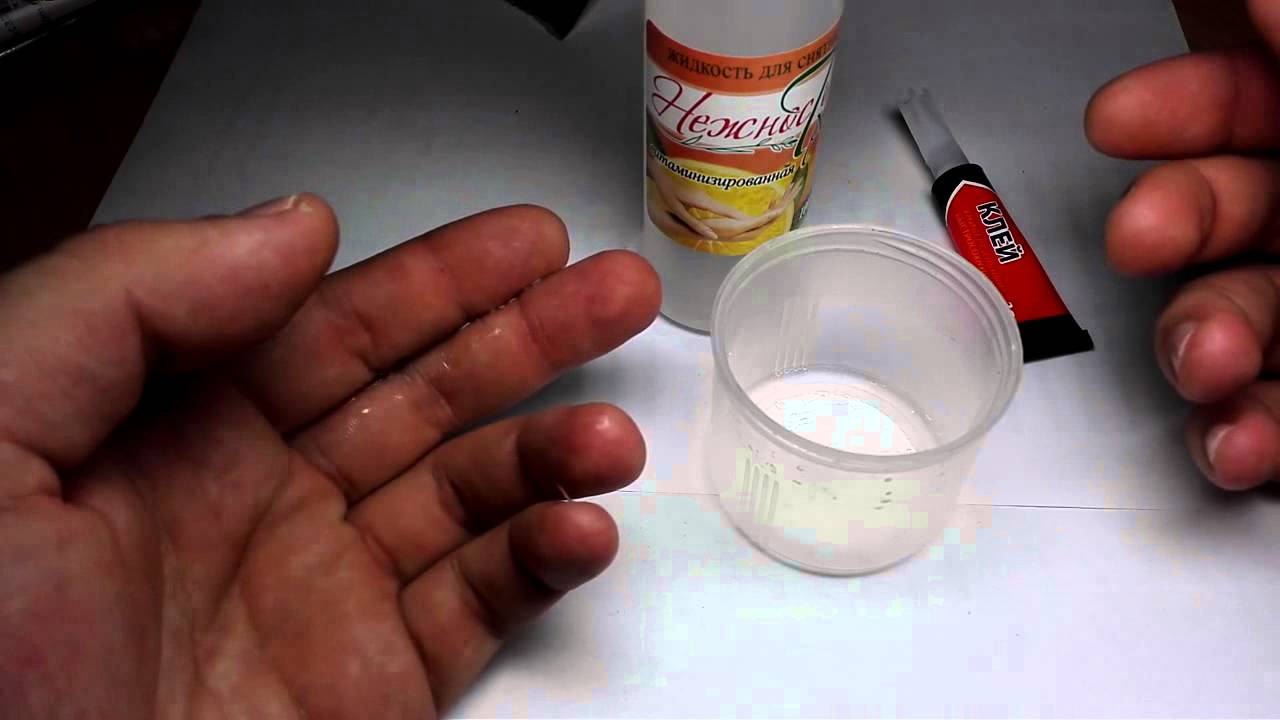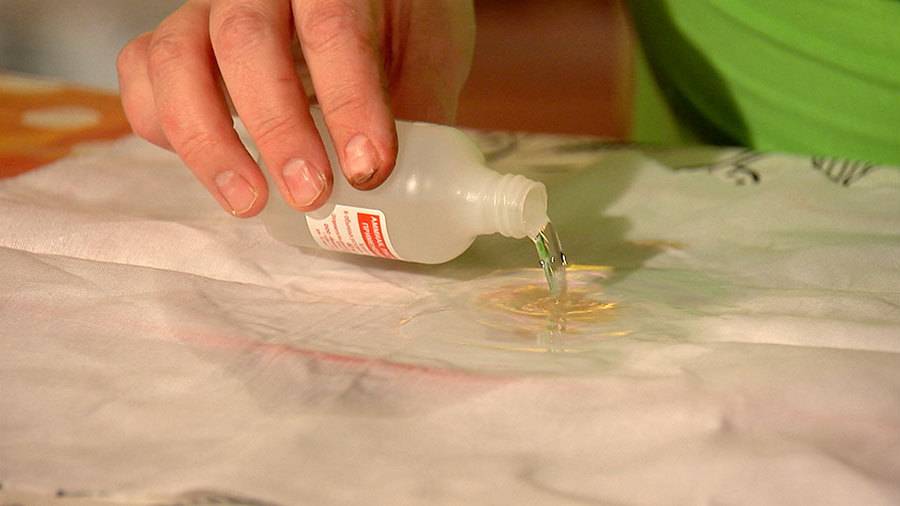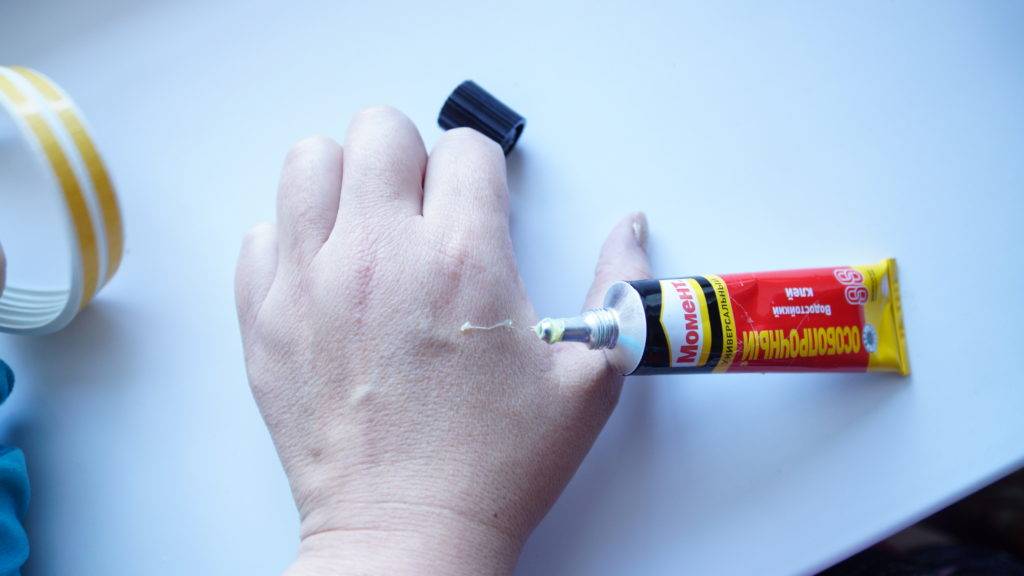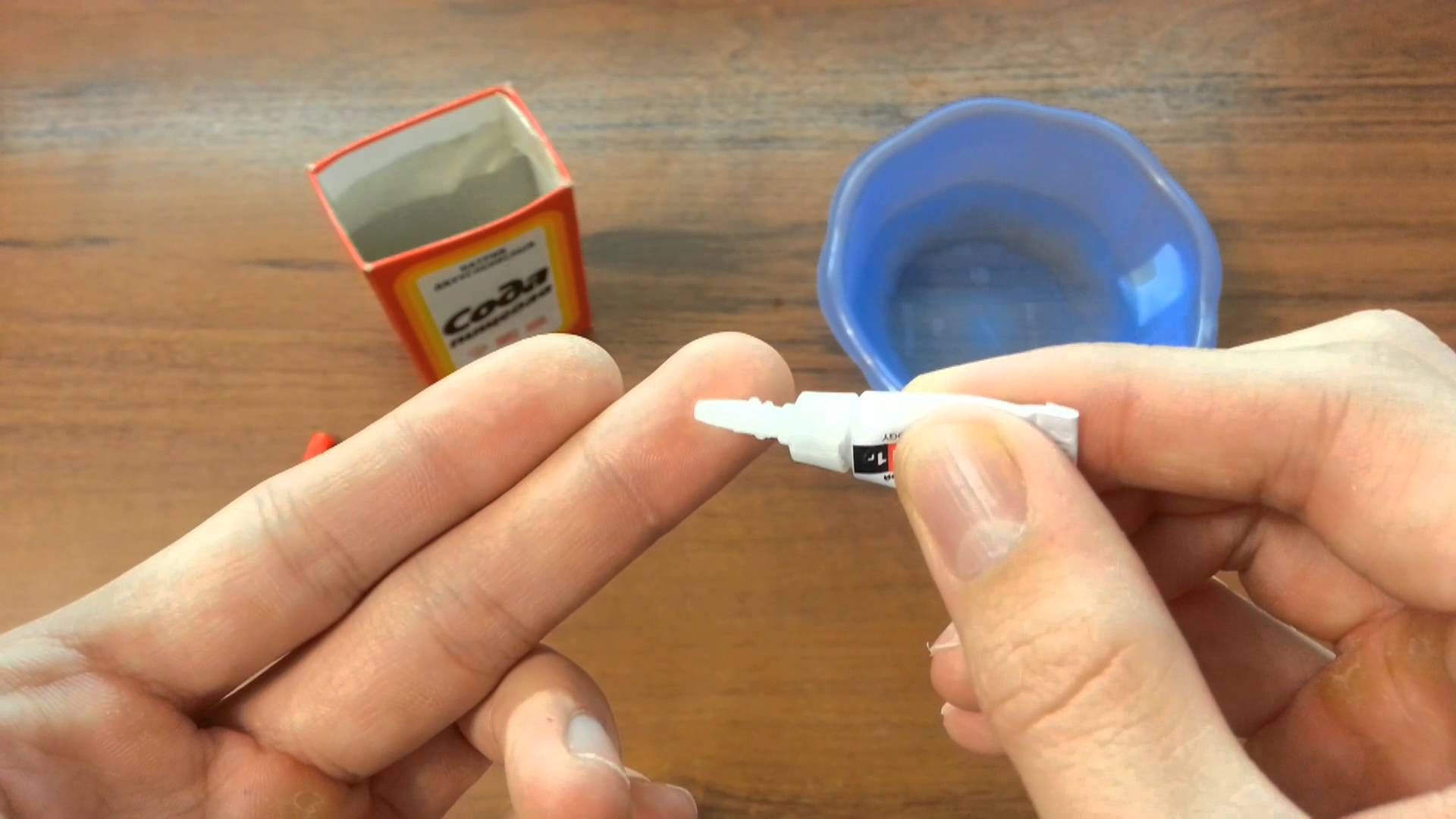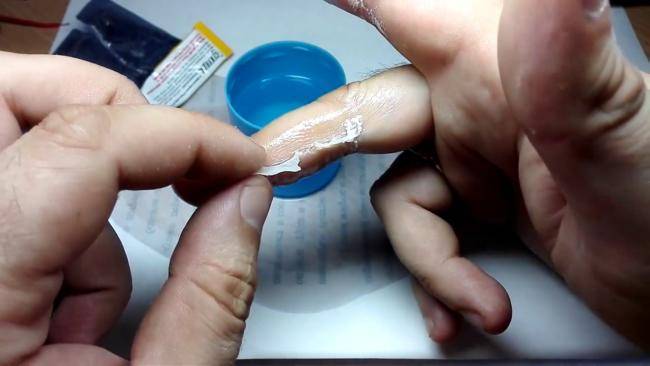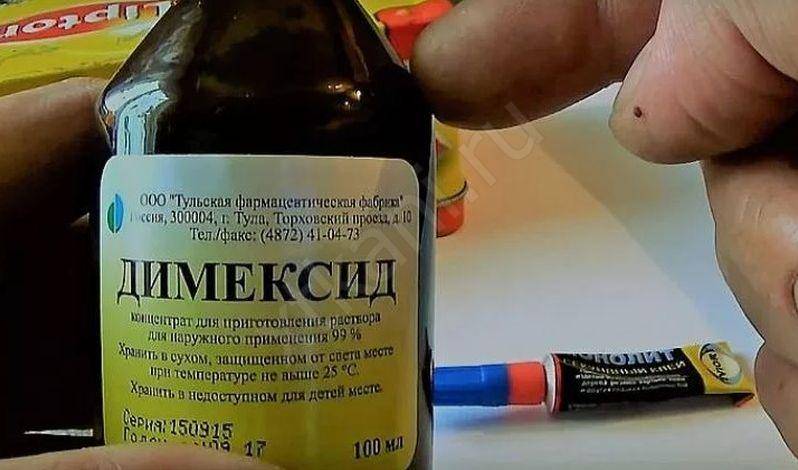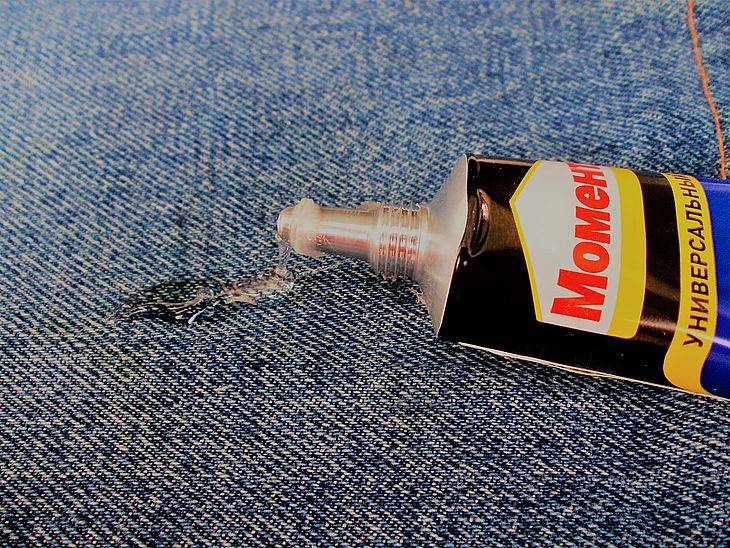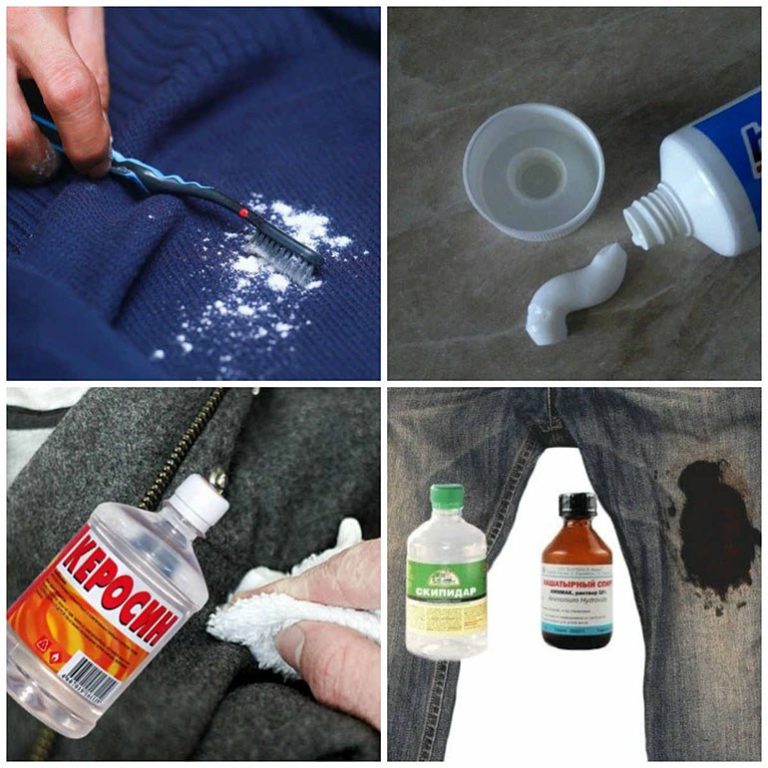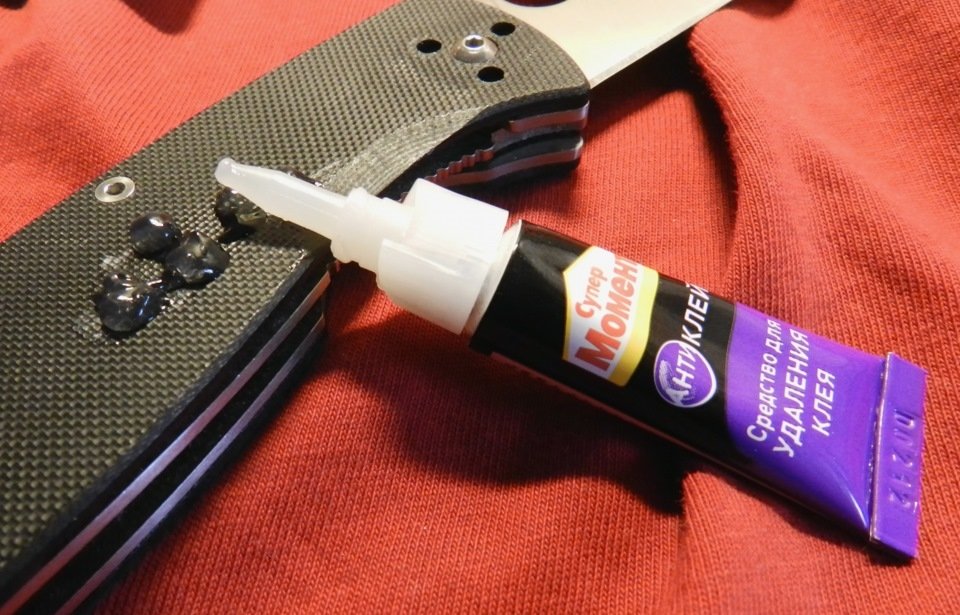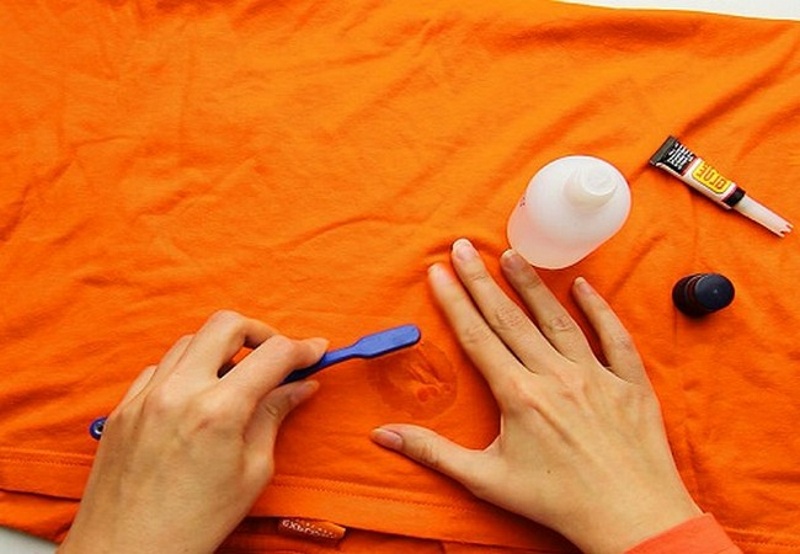Folk ways
When chemicals are not within reach, or they are unacceptable for some reason, folk methods will come to the rescue.
Butter
It is convenient to use the oil to remove the "Super Moment" from the skin. The method is very gentle, does not cause damage, but, on the contrary, provides additional care. For this method, you can take butter or any vegetable oil. The contaminated area is treated with a greasy agent until the glue begins to peel off. Most likely, the procedure will need to be repeated several times.
The oil can also be applied against glue stains on varnished surfaces, plastic, silicone - materials that will not withstand solvent. The product does not dissolve glue residues, but will help peel off the stain. Not recommended for untreated wood as it is very difficult to remove traces from wood.

Table vinegar
Vinegar is often used to remove superglue from natural fabrics. The injured piece of clothing is soaked for 10-15 minutes in a solution of water and vinegar (1 glass of vinegar per 1 liter of warm water), after which the glue is scraped off and dried residues are removed with tweezers. The method is not used for synthetic fabrics.
Soda or salt
Salt is often used to remove superglue residues from the skin of the hands. To do this, moisten the skin with water, sprinkle the stain with salt and actively rub it for several minutes, after which it is washed off with warm water. If necessary, repeat several times. With this technique, salt acts as a scrub.
Hair dryer
The contaminated area is heated with hot air, softening the glue for its further removal mechanically. The method is ineffective with respect to cyanoacrylate, which is not afraid of a slight increase in temperature, therefore it is rarely used.
Hydrogen peroxide
The product will help to remove dried glue residues from the skin of the hands, as well as from metal surfaces. Rub the soiled area with a cotton pad moistened with peroxide or a piece of cloth until the stain completely disappears.

Warm water
Most often, warm or hot soapy water is used to clean superglue from hands and clothing. You can take a bar of soap or liquid soap, for the skin it will not hurt to supplement the method with any scrub. If the glue has frozen on the clothes, the fabric is placed as quickly as possible in boiling water, spot down (for this, it is more convenient and quickest to boil an electric kettle), left for 5 minutes, then scraped off with a blunt object or removed with tweezers. If the material is afraid of boiling water, then the affected piece of clothing is washed by hand in warm soapy water.
Lemon acid
A citric acid solution will help to cope with not very old stains on the fabric. To prepare it, you will need 1 tablespoon of powder and a glass of water. The glue spot is moistened with a solution and left for half an hour or an hour, after which it is manually washed in warm water and soap.
Fat, margarine, petroleum jelly, olive oil
Any oily product is suitable to peel off the dried "Super Moment" from the skin of the hands, especially for delicate baby skin. Fat is abundantly applied to the dirt, rubbed into it, trying to pick it up by the edge and remove the peeled glue. After the hands are washed with warm water and soap.
High or low temperature
Some types of super glue cannot withstand high temperatures. In this case, it is convenient to remove their traces from the fabric with an iron. On both sides, the contaminated area is sandwiched with a thick layer of napkins or a light cotton cloth and ironed, while the glue is heated and absorbed into the napkins. The freezer will help you get rid of the glue that is unstable at low temperatures.The soiled piece of clothing is placed in the freezer for several hours, after the glue remains become brittle, they are removed with tweezers.

Mechanical
When choosing a mechanical method, it must be borne in mind that in this way it is very easy to scratch the surface to be cleaned. And if “Super Moment” can be removed from the fingers simply by rubbing the stain with a scrub, without causing any particular harm to the skin, then abrasives or scraping will cause irreparable damage to glass or plastic. Other types of glue, for example, PVA, pick up the edge of the dried spot and tear it off the surface, but it is better to use a solvent or detergent to remove superglue.
Alcohol and ammonia
Ammonia or ammonia is good because it does not corrode the surface to be cleaned. The tool is used to remove superglue from glass, plastic, furniture, laminate, clothing. It is applied to dirt and wiped off as it softens.
Will it be possible to remove dirt with an iron?
You can remove superglue from clothes with an iron. As you know, superglue is afraid of high temperatures and, under the influence of 80 ° C and above, it is able to melt and fall behind clothes on its own. How to do it:
- 1 Spread the glue-soiled item on a flat surface and place any clean cloth underneath it.
- 2 The iron should be heated to the maximum temperature and lean against the place on the clothes where the adhesive was spilled, using a piece of natural cotton fabric or a handkerchief as a spacer between the iron and the material. The fabric or handkerchief should be monochromatic so as not to leave traces of paint on the surface.
- 3 Using a hot iron, iron the place on the fabric where the glue was spilled for a few seconds, periodically checking the condition of the glue base on the surface. When the glue begins to soften its structure, you can try to scrape it off with a blunt edge of a knife or other convenient object.

After removing the glue from the surface of the clothes, the item must be soaked in warm water with detergent or stain remover for a few minutes, and then washed as usual or by hand.
How to wipe off traces of masking tape
When choosing a method for cleaning traces of masking tape, it is necessary to take into account the type of material, since glass, plastic and wood react differently to external influences.
Plastic cleaning

To wipe off the remnants of masking tape from the plastic, you will need:
- Mix together a tablespoon of baking soda and water so that a mushy substance is formed.
- Apply the compound to the contaminated surface.
- Wait no more than three minutes and rinse with water.
A school eraser is used to quickly remove the remnants of the tape. A similar effect is given by a specialized tool for cleaning glue from plastic. Also, toothpaste is used to remove traces of masking tape. Using a sponge (rag), this cleaning agent should be applied to the contaminated area, wait 5 minutes and rinse with water.
Metal cleaning
Kerosene, white spirit, acetone and gasoline help to clean the remains of masking tape from metal. To remove stains you need:
- Soak a cloth in any of the liquids listed.
- Wipe off any remaining adhesive tape until traces disappear.
- Rinse the surface with a cloth dampened in clean water.
For the second method of cleaning traces of masking tape, you will need a refrigerant. This substance is sold in cans in hardware stores. To wash the adhesive from the masking tape from metal surfaces, you need:
- Spray the refrigerant at a distance of 10-15 cm, holding the can for 3-4 seconds.
- Using a rubber trowel, wipe off the dirty area. Re-spray if necessary.
- Wipe the surface with a damp cloth.

To remove the remnants of the adhesive tape from the metal surface, specialized means are also used that not only get rid of dirt, but also restore the previous shine of the material.
Glass cleaning
To remove traces of adhesive tape from glass help:
- acetone;
- petrol;
- nail polish remover;
- alcohol;
- window cleaner containing alcohol.
To clean the glass, each of these liquids must be applied to the contaminated area, wait no more than a minute and wipe with the hard side of the foam sponge.
Old traces are removed by a hairdryer in combination with soda. To do this, you must first heat the contaminated area. Then you need to place a tablespoon of baking soda in water until a slurry state, apply the mass on the glue with a sponge and wipe the rest of the tape.
Wood cleaning
Regardless of the type of wood surface, the following method is used to clean up adhesive tape residues:
- 2-3 drops of sunflower oil are applied to the sponge.
- The traces of the adhesive tape are rubbed with a sponge.
- Wait 30 minutes and wipe the surface with a terry (paper) towel.
- Mix a teaspoon of detergent (aggressive is recommended) and a glass of vinegar.
- Pour the mixture into a spray bottle, shake and apply to the contaminated area.
- Wait a minute and wipe off any remaining oil with a paper towel.
When cleaning masking tape from furniture, follow the manufacturer's advice. In order not to spoil the product, first wipe the contaminated area with a school eraser. If this method does not work, you can apply essential oil to the remaining glue, wait 5 minutes and remove with a soft sponge. After this procedure, the surface must be wiped with a damp cloth.
Despite the fact that the glue from the masking tape penetrates deeply into the structure of the material, you can remove the remnants from the tape using household products. It is necessary to take into account what the contaminated surface is made of, and in accordance with this, select cleaning methods.
How to work properly with glue Moment
To avoid marks on clothes and shoes, furniture, electronics, you should be careful
However, even with careful handling, sometimes liquid will spill onto the floor or skin, leaving stains. You can avoid this by using the following tips:
Use gloves. Only rubber gloves are suitable, as fabric gloves can react, generate heat and leave a burn on the skin of the hands.
Protect the surface from glue. On the table or on the floor where the work will be carried out, it is necessary to lay cellophane, an old tablecloth or thick fabric. It is better to glue the parts in unnecessary clothes or wear an apron.
Distribution of glue. Lubricate the surface with glue with a spatula, stack or stick
In no case should you do this with your hands - in just a few seconds the skin can stick to the thing.
Precautionary measures. The moment gives off fumes, which is often the reason for an allergic reaction
It will not hurt to use goggles and a respirator if you have to work with glue for a long time. It is highly flammable and should not be used near fire.
Clay Moment is a real helper that many have in the house. Able to glue wood, plastic, metal and many other materials. Sometimes, in the course of work, traces remain on the surface, which can be washed off with special substances or household products.
5 Solvent
Acetone acts most effectively on cyanoacrylate. It is applied to a sponge or soft cloth and the contaminated area is rubbed. Sometimes, to enhance the effect, they make a kind of compress, applying a material moistened with acetone on the glue crust. It is fixed with a plaster or tape, left for 8-10 minutes. As an analogue, you can take a liquid for removing nail polish from nails, but only the one where acetone is present. Its content is small, so it will take more time to get a satisfactory result.

Instagram furman_remover

Instagram stroyavl
White spirit, gasoline will help to clean your hands. They are used in a similar way to acetone. Before using aggressive substances, it is advisable to do a safety test. A small area of skin is moistened with a selected solvent. If after a while there is no irritation or redness, you can use it. If it does, you will have to look for another cleaning method.
How to wash off
When it becomes impossible to avoid the ingress and solidification of a chemical on the skin, it is necessary to take measures to remove it. There are several ways to remove traces of glue at home.
Mechanical method
You can wipe off the solidified product using a mechanical method. It consists in cutting with a sharp instrument or tearing off the top layer of a chemical product. Mechanical removal can leave painful damage to the skin.
Soap and plastic bag
To rinse the glue off your hands, you can use a simple removal method with a plastic bag and a bar of soap. You should take the package in your hands and rub the contaminated areas with it. The glue will stick to the polyethylene, so the skin can be easily cleaned of the chemical. The procedure should be repeated until the skin is completely cleansed. After that, hands are soaped and washed under running water.
Solvents
A quick and effective method is hand degreasing. Most solvents have a strong odor and high toxicity.
Important: handling hands with solvents is recommended in a well-ventilated area or outdoors.
Acetone
If a little time has passed from the moment of contamination, you can remove the cured silicone with an aggressive solvent. Soak a cotton pad in acetone and wipe the contaminated area.
White Spirit
White-spirit can effectively cleanse pollution. To do this, moisten a lint-free cloth in the solution and treat the oiled leather. After 2-3 minutes, the solution is washed off, and the hands are washed in soapy water.
Alcohol
You can use 90 percent alcohol to cleanse your skin. With a cotton swab soaked in alcohol, it is necessary to thoroughly wipe the hardened glue. You cannot rub for a long time so as not to dry the skin.
After the procedure, hands are washed in warm water with soap and greased with cream.
Vinegar solution
To prepare the solution, vinegar and water are taken in equal proportions. Then the hands are wiped with the resulting liquid, everything is washed off with soapy water. Laundry soap is recommended. It will wash away the remains of the vinegar solution without leaving a trace.
Vegetable oil and washing powder
The skin of the hands is rubbed from the mounting glue with sunflower or other vegetable oil. The procedure is performed as follows:
- half a glass of oil is taken;
- heated in a water bath;
- washing powder is added to the container to the oil;
- the soiled areas are wiped with a mixture.
After thorough treatment, hands are washed in running water.
Removal wipes
Hardware stores offer disposable wipes to remove cured mounting fluids. They are impregnated with a special solution that removes glue well on a different basis.
After completing the repair work, you should wipe your hands well with napkins and rinse in warm water.
Removing super glue from different surfaces
Superglue is a good helper for many small repairs. It can glue wood countertop, plastic products, phone case and other materials. But it can also cause trouble if it gets on things that are not intended for gluing ... The most unpleasant thing is if the glue gets on your hands or on your favorite clothes
When washing off the adhesive, take into account the properties of the material on which it is located.
Skin cleaning
Do not remove superglue by literally tearing apart each other with your finger. In addition to injury, this method will not give anything. For cleaning, you can use either chemical or home remedies.

Removing superglue from hands
The first way you can remove the second glue from the skin of your hands is a scrub. Everyone knows the effect of peeling on the skin. It removes dead cells on the surface, smoothes it, makes it elastic and healthy. Due to the content of small abrasive particles, the scrub will help in removing the substance from the hands. Pick up any scrub in your hand, rub it between your fingers. Then rinse.
The American housewives' way of using peanut butter. It contains small pieces of peanuts that act like a scrub.
Rinse cleansed skin with water, saturate and moisturize with cream.
Textile cleaning
Wash the fabric thoroughly in warm water, then rub gently. Be careful not to damage the fabric when removing super glue marks. Try to remove as much glue as possible
If the fabric is thick (no risk of damage), try to gently scrape off the stain. You can soak your fingers in the oil to make it easier to remove sticky stains.
Removing superglue from clothes
For stubborn stains, use an effective solvent that will clean the fabric without damage.
For home use, acetone-containing nail polish remover is suitable.
If nothing sucks, don't expect a new item in your wardrobe that will surely delight you.
Cleaning suede
First, try to gently scrape the glue off the suede with your fingernails. Do not damage the material. You can try wetting the stain with hot water (only the stain itself, not the surroundings!) To help soften the glue.
If all else fails, try a thinner
When working with acetone, be careful, apply it first on a hidden area to make sure there is no discoloration of the suede
Cleaning smooth hard surfaces (marble, glass, tiles)
Superglue can be easily removed from hard, smooth coatings. It will help remove adhesive from glass, marble, tiles and even a car panel (acetone can be used to remove adhesive from a car body). Rub rubbing alcohol onto the stained area until the glue dissolves. Remove the remaining parts with a cloth soaked in detergent.

You can remove the glass from the superglue with a blade, finishing the process by wiping with soapy water and polishing.
Removing super glue from wood surfaces
When cleaning superglue from furniture and other wood products, you can choose one of the following options:
- Scraping with nails. If the adhesive is thin, this may help.
- Acetone. This method is used mainly for cleaning lacquered surfaces. Wipe the stain with a cloth dipped in acetone. After softening, remove the residues with a rubber scraper, wash with soapy water.
- Grinding. If the stain is large and the previous methods do not work, the only option is to use sandpaper. After sanding and washing the cleaned wood, polish it.
Cleaning the laminate
When removing adhesive stains from laminate flooring with cleaning agents, it is important to look at the recommendations for application on this type of flooring. Most suitable remedies:
- Cif Cream. Ideal for cleaning PVC and laminate super glue.
- Debonder. Able to remove the adhesive layer without damaging the surface.
- Mineral oil. Dip a cloth in oil, wipe the glue drops until their edges begin to rise slightly. Then wash off the oil with a cloth soaked in warm water and soap, polish the surface.
Cleaning screens and monitors
The best way to clean the surface, phone display, or laptop screen is with Dimexide. Apply it with a cotton pad.
Cleaning of lock cylinders and metal
Superglue dissolves well isopropyl alcohol.
Expert opinion
Irina Kovtun
The mentioned Dimexidum, White spirit, special cleaning agents (Anticlea, Debonder) will also help to eliminate the dried glue.
2> Other funds
Any detergent will help get rid of the quick-drying glue, but they are only suitable for those whose skin tolerates contact with powder and gel well. Depending on how badly your hands are soiled, they are immersed in a bath of water, where the product is added, or wiped with a solution. The contamination should soften throughout its entire thickness, after which it can be removed without problems.
If the skin tolerates cold well, it is worth trying to separate the glue with ice. It is wrapped in a napkin or applied like this. The glue becomes fragile, disintegrates into pieces and in this state falls well off the hands.
Another option for removing the Moment glue from your hands is a mixture of sugar, lemon juice and water. This paste is usually used for sugaring. You need to act like this:
- mix the ingredients;
- warm up the mixture;
- apply to contaminated skin;
- grind;
- rinse with water.
If the glue layer on your hands is rather thick, you should try to remove it with a vinegar solution. The composition is moistened with contamination, and after 2-3 minutes it is washed. If it was not possible to remove the stain from the first time, the procedure is repeated. In this way, you can get rid of glue residues on clothes, furniture and carpets.
How to remove patch marks from baby skin
In children, the skin is delicate and vulnerable, so chemical solvents can cause allergic irritation.
Care must be taken when choosing a glue remover after the patch. If one method does not work, then before trying another remedy, you need to give your skin some rest.
Vodka
Vodka copes well with the problem, it acts more sparingly than alcohol. Moisten a finger in vodka and gently run it over the skin where the glue has accumulated. After 5 minutes, this area of the body is wiped with a dry napkin and smeared with cream.

Vegetable oil
Under the influence of vegetable oil, the glue that remains after applying the patch becomes softer and slightly dissolves. You can take a special cosmetic oil that is intended for baby skin, or a lotion. But sunflower, linseed or olive oil will cope with the problem just as well.
The procedure is simple:
- A piece of bandage or a cotton swab is moistened with a little oil.
- Apply to the problematic part of the body where the glue remains.
- Wait 5 minutes.
- Remove residual oil with a damp cloth.
The procedure is safe, if necessary, it can be repeated several times. To prevent a small child from being capricious, you can first add a little food coloring to the oil and turn the procedure into an exciting game.

Ways to remove super glue stains
Options for how to clean clothes from superglue, wipe off its remnants from your fingers, clean a plastic, wooden surface are divided into:
- chemical (use of cleaning agents);
- professional (use of products designed to dissolve superglue);
- mechanical (scraping);
- folk (using folk cleaning tips).
Professional method
The best way to remove superglue from your hands is to use a special superglue dissolver. It is designed specifically for applications where the adhesive goes where it is not needed. It also serves to remove poorly adhered joints. It can clean leather, furniture, and can remove superglue from clothing, plastics, wood, and even polished surfaces.
Chemical method
People often use cyanoacrylate adhesives at home, which makes it almost impossible to remove them from solid objects. But there is a tool that can dissolve even the most resistant adhesive - Debonder and remove the adhesive layer without damaging the material. It is effective in removing other sticky substances and can serve as an aggressive cleaning agent. Debonder is suitable for cleaning glass surfaces (incl.glasses), it can wash traces of glue from skin, nails, from a sofa, from a table, chairs and other objects.
Another way to wash superglue off your hands is to use WD-40.
Substance Anticlea is the next option than to wash superglue from hands and most objects and materials.

Dimexide
Dimexide is a remedy for external use, also used to eliminate various contaminants. It will help clean glass, remove traces of superglue from plastic, glasses, wood surfaces and even screens, monitors.
Nail polish remover and acetone
This is a very fast and efficient solution. Acetone acts as a cyanoacrylate solvent and therefore rapidly dissolves the adhesive. Soak a cloth in acetone, wipe off the dirt. Then peel off the glue, starting from the edges. Then you should wash the cleaned area with soapy water.
Gasoline, White spirit
These substances are not the most fragrant ways to clean various materials from superglue (it will also help wash it off the skin of your hands), but they are effective. Use in the same way as acetone.
Folk ways
In deciding how to wash superglue from your hands at home, folk remedies can be a good helper. Their use has much fewer contraindications than the use of a chemical cleaner.
Warm water
If the use of suitable chemicals is not possible, water will help to wash your hands of the superglue. The effect provides for the sweating of the hands, the release of fat, which separates the glue.
Vinegar
One way to clean superglue from clothes at home is with vinegar, which is good for removing Moment from any kind of fabric. You should first check if it damages the thing. Vinegar can be used to clean the second glue ("Moment") trousers, dresses, jackets and other items of clothing. But vinegar is most suitable for removing drops of glue from clothes made of thin fabrics, since it is one of the most gentle substances.
Lemon juice or acid
Lemon is the least aggressive superglue solvent. It effectively wipes off the adhesive from fingers, linoleum, metal and other surfaces. In a circular motion, rub the superglue drops with lemon juice or acid solution until the substance at the edges begins to flake off.
Olive oil, fat, margarine, petroleum jelly
Apply any of the specified substances to your fingers or any coating. Loosening the "grip" of the super glue will provide easy peeling.
Soda or salt
This method will help clean your hands of any glue that has not yet dried. 2 tbsp. l. Mix soda or salt with water to create a paste. Apply to stain, rub. Repeat the cleaning process until the substance is completely dissolved.
Exposure of glue to different temperatures
High and low temperatures have the opposite effect on the second glue. At high temperatures, the substance softens, at low temperatures it becomes more brittle.
Mechanical cleaning
Due to the fast drying of super glue, it is relatively easy to mechanically clean smooth surfaces. Removing the top layers, you can speed up cleaning with a blade, knife. Remove the remaining small droplets with a nail file
Caution, this method is not recommended for removing adhesive from fingers, as
there is a risk of skin damage.
Why is the Moment glue dangerous?
The adhesive contains components that are water-resistant; it will simply not work to remove it with water. It is necessary to remove the Moment glue from the skin as soon as possible.
A small amount of superglue should be immediately cleaned with water and held with your fingers in soapy water, then remove the remaining glue with a stiff sponge. Repeat the steps until the super-remedy disappears completely. This procedure will take a little over ten minutes.
Do not use gasoline, kerosene. These substances wipe away stains from the gluing surfaces of furniture, fabrics, shoes, leather goods. They not only negatively affect the respiratory tract, but also cause allergic reactions.
Human skin is renewed every month. Glue, when it gets on parts of the body, does not penetrate deeply into the epidermis. If it has not disappeared completely, then it will disappear in a few days with dying skin areas on its own. The glued fingers cannot be separated sharply; this must be done gradually, with rotational movements.
Mechanical scraping
How to remove Moment glue from the skin using abrasive devices:
- A pumice stone or a stiff brush will wipe off the product very well after a soapy solution. It is enough just to wipe off the dry stuck together areas of the skin, but the main thing is not to overdo it and not damage the surface of the epidermis. The result will not be the most satisfying - some areas will remain uncleaned, but this natural exfoliation method is the most gentle.
- Lady's nail file. With it, gently pick up and cut off the skin. But using a nail file is fraught with injuries, and sticky residues will still have to be removed by other means.
Special formulations
In construction and specialty stores, chemicals are sold for dissolving superglue. The composition is applied to the stain, kept for the time specified in the instructions, then removed with warm water and soap.
Anticlee is usually used to scrub the surfaces of furniture or clothing, but it is also safe for humans. It is enough to unscrew the tube, pierce the membrane and apply the gel to the surface of the hands. You need to wait 7 minutes, then use a fiber and wash off the chemistry in running warm water.
Folk remedies
Folk remedies are simple, and every housewife can find:
- Salt - soak your hands in warm water before the procedure. Then sprinkle some salt on the skin and rub in for a few minutes. Clean the formed white paste with running water. Repeat the procedure if necessary. You can use a saline solution by adding lemon juice to it. Add 2 tbsp. To a warm bath. tablespoons of salt and soak your hands.
- Baking soda - put your hands in a saucer of warm water, then rub the baking soda into the glue, wash with a warm stream under the tap.
- Alcohol or vodka - dip your hands in alcohol for about a minute until you acquire a whitish appearance. The fingers slowly begin to recede, and the glue itself is removed from the skin, like a crust.
- Vegetable, almond, butter or margarine - rubbed into the skin until all stains are wiped away. Natural ingredients are very suitable for sensitive skin, provided that the glue is not absorbed deeply.
How to scrub glue with household products
Household kitchen dishwashing detergents will do an excellent job of removing adhesive film. They must be dissolved in a 1: 4 ratio and wiped off your hands with a sponge or washcloth. This removal method will take 5-10 minutes. You can soak your hands in the solution and wait 20-25 minutes until the adhesive is completely removed.
We recommend:
DIY ceiling dryer
Ways to remove glue at home
The following means are used to remove the glue:
- Any brand of hand cream, including children's, is suitable for people with dry sensitive skin. It should be applied to a dirty place, wait a while and begin to remove the glue. The cream softens the epidermis and the adhesive itself, which makes it easy to remove.
- Petroleum jelly is also an aid in removing the remaining substance when rubbed into the skin.
- A feminine cosmetic scrub can be used instead of salt.
- Dimexide can be used to lubricate a cotton pad. It heats the fingers, dissolves the glue, the procedure should be carried out in the first minutes after the glue gets in. According to its composition, Dimexide is an excellent anti-inflammatory agent.

